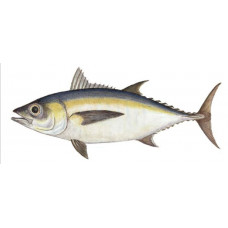Latin name
Thunnus atlanticus
Other names
Bermuda tuna, blackfinned albacore, deep-bodied tunny; French: bonite, giromon, thon nuit; Japanese: mini maguro, monte maguro, taiseiyo maguro; Spanish: albacora, atún aleta negra.
Identification
The pectoral fins of the fish reach somewhere between the twelfth dorsal spine and the beginning of the second dorsal fin, but never extend beyond the second dorsal fin. The first arch has a total of 19 to 25 (usually 21 to 23) gill rakers (15 to 19 on the lower limb), fewer than any other Thunnus species. The fins are uniformly dark, without the shade of bright lemon-yellow that is typically present in other tuna, and may have white edges. Light stripes alternate with light spots on the lower flanks. The first dorsal fin is dusky. The second dorsal and anal fins are also dusky, with a silvery sheen. The back of the fish is bluish-black, the sides are silvery gray, and the belly is milky white. There is a small swim bladder. The ventral surface of the liver is stripe-free; the right lobe is longer than the left and middle lobes.
Distribution
A fish native to tropical and warm temperate waters of the western Atlantic from Brazil to Cape Cod, including the Caribbean and the Gulf of Mexico. It is most common from North Carolina southward and is Florida's most abundant tuna.
Habitat
Pelagic fish.
Size
Maximum lengths can reach 40 inches, although they are usually found to be about 28 inches long and weigh 10 to 30 pounds. The world record in all tackle is considered to be a Florida fish weighing 45 pounds 8 ounces.
Life history and Behavior
The spawning grounds are thought to be far out to sea. Off the coast of Florida, the spawning season lasts from April to November, with a peak in May. In the Gulf of Mexico, it lasts from June to September.
Food and feeding habits
The diet consists of small fish, squid, crustaceans, and plankton. The fish often feed near the surface and form large mixed schools with skipjacks.
Reproduction
No information
| Classification | |
| Phylum | Chordata |
| Class | Actinopterygii |
| Squad | Scombriformes |
| Family | Scombridae |
| Genus | Thunnus |
| Species | T. atlanticus |
| Features | |
| Conservation status | Least Concern |
| Habitat | Pelagic |
| Life span, years | No information |
| Maximum body weight, kg | 21 |
| Maximum length, cm | 100 |
| Sailing speed, m/s | No information |
| Threat to people | Edible |
| Way of eating | Predator |


